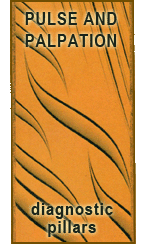The Confined, Firm Pulse (Lao Mai)

Confined Pulse (牢脈 Lao Mai, firm) Key points: deep, forceful, wide, taut, long, stable. Indications:interior excess cold (hernia, lumps, masses): yin cold traps yang qi within, can\’t rise to the surface.
 Last modified: August 12, 2009 ·
Last modified: August 12, 2009 ·  al ·
al ·  No Comments
No Comments
 Tags: Diagnosis, Palpation · Posted in: Pulse Class, Pulse-Palpation
Tags: Diagnosis, Palpation · Posted in: Pulse Class, Pulse-Palpation
The Hidden Pulse (Fu Mai)

Hidden Pulse (伏脈 Fu Mai) key point: very deep. Indications: (forceful) pathogens obstructing the interior: qi and blood cannot flow or lift externally.
 Last modified: August 11, 2009 ·
Last modified: August 11, 2009 ·  al ·
al ·  No Comments
No Comments
 Tags: Diagnosis, Palpation · Posted in: Pulse Class, Pulse-Palpation
Tags: Diagnosis, Palpation · Posted in: Pulse Class, Pulse-Palpation
The Leather, Tympanic, Drum-Skin Pulse (Ge Mai)

Leather Pulse (革脈 Ge Mai, tympanic, drum-skin) Key points: superficial, forceful, taut, wide, and hollow Indications: blood loss, abortion, jing exhaustion: sudden loss of blood or jing causes qi to float with the hollow insides due to sudden lack of blood or jing.
 Last modified: August 10, 2009 ·
Last modified: August 10, 2009 ·  al ·
al ·  No Comments
No Comments
 Tags: Diagnosis, Palpation · Posted in: Pulse Class, Pulse-Palpation
Tags: Diagnosis, Palpation · Posted in: Pulse Class, Pulse-Palpation
The Hollow, Scallion Stalk, Onion Pulse (Kou Mai)

Hollow Pulse (芤脈 Kou Mai, scallion stalk, onion)Key points: floating, wide, slack, with an obscure center.
 Last modified: August 9, 2009 ·
Last modified: August 9, 2009 ·  al ·
al ·  No Comments
No Comments
 Tags: Diagnosis, Palpation · Posted in: Pulse Class, Pulse-Palpation
Tags: Diagnosis, Palpation · Posted in: Pulse Class, Pulse-Palpation
The Slow Pulse (Chi Mai)

Slow Pulse (<60 bpm) (遲脈 Chi Mai)key point: slow. Indications: (forceful) cold accumulation: cold causes constriction and contraction leading to slowed movement.
 Last modified: August 8, 2009 ·
Last modified: August 8, 2009 ·  al ·
al ·  No Comments
No Comments
 Tags: Diagnosis, Palpation · Posted in: Pulse Class, Pulse-Palpation
Tags: Diagnosis, Palpation · Posted in: Pulse Class, Pulse-Palpation
The Moderate, Slowed-down, Lax, Retarded, Leisurely Pulse (Huan Mai)

Moderate Pulse (緩脈 Huan Mai, slowed-down, lax, retarded, leisurely)Key points: feels slow to the fingers, but normal by the clock. Indications: Dampness: sticky substance impedes flow of qi and blood in vessels.
 Last modified: August 7, 2009 ·
Last modified: August 7, 2009 ·  al ·
al ·  No Comments
No Comments
 Tags: Diagnosis, Palpation · Posted in: Pulse Class, Pulse-Palpation
Tags: Diagnosis, Palpation · Posted in: Pulse Class, Pulse-Palpation
The Rapid Pulse (Shuo Mai)

Rapid Pulse (90-140 bpm) (數脈 Shuo Mai) key point: fast. Indications: (Forceful) Excess heat: excessive heat stimulates the circulation of the qi and blood.
 Last modified: August 6, 2009 ·
Last modified: August 6, 2009 ·  al ·
al ·  No Comments
No Comments
 Tags: Diagnosis, Palpation · Posted in: Pulse Class, Pulse-Palpation
Tags: Diagnosis, Palpation · Posted in: Pulse Class, Pulse-Palpation
The Racing, Hurried, Urgent, Swift Pulse (Ji Mai)

Racing Pulse (疾脈 Ji Mai, hurried, urgent, swift) key point: extremely rapid (over 140 bpm) Indications: (Forceful) Excess heat: heat excites movement of blood leading to the rapid pulse.
 Last modified: August 5, 2009 ·
Last modified: August 5, 2009 ·  al ·
al ·  No Comments
No Comments
 Tags: Diagnosis, Palpation · Posted in: Pulse Class, Pulse-Palpation
Tags: Diagnosis, Palpation · Posted in: Pulse Class, Pulse-Palpation
The Consistently Irregular, intermittent, or regularly intermittent pulse (Dai Mai)

Consistently Irregular Pulse (代脈 Dai Mai, intermittent, regularly intermittent) Key points: regularly missed beats Indications: (Rapid) Wind, pain, emotional shock: pathogenic factors cause qi stagnation leading to intermittent pauses in the pulse.
 Last modified: August 4, 2009 ·
Last modified: August 4, 2009 ·  al ·
al ·  No Comments
No Comments
 Tags: Diagnosis, Palpation · Posted in: Pulse Class, Pulse-Palpation
Tags: Diagnosis, Palpation · Posted in: Pulse Class, Pulse-Palpation
The Rapid Irregular, Hasty, Abrupt, Skipping Pulse (Cu Mai)

Rapid Irregular Pulse (促脈 Cu Mai, hasty, abrupt, skipping) Key points: rapid with irregular pauses. Indications: (Forceful) excess heat (causing stagnation), or stagnation (generating heat.
 Last modified: August 3, 2009 ·
Last modified: August 3, 2009 ·  al ·
al ·  No Comments
No Comments
 Tags: Diagnosis, Palpation · Posted in: Pulse Class, Pulse-Palpation
Tags: Diagnosis, Palpation · Posted in: Pulse Class, Pulse-Palpation
